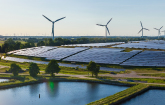LONDON, Aug. 23 /PRNewswire/ -- As the burgeoning wind and solar power markets continue to expand, industry value chains are looking to adopt measures to sustain anticipated growth. For many component producers, the market growth rate will translate into a need to increase existing capacities, build new plants and spread out to new geographies.
(Logo: http://photos.prnewswire.com/prnh/20081117/FSLOGO)
(Logo: http://www.newscom.com/cgi-bin/prnh/20081117/FSLOGO)
According to a recent study performed by Frost & Sullivan, (www.power.frost.com), titled Overview of the Investment Attractiveness of Selected Parts of the Value Chain: Wind and Solar Power, markets for certain components of the wind and solar industry will present budding opportunities for new entrants, as growth rates are expected to exceed present manufacturing capacity.
"The rapid expansion of wind and solar power installed capacity led to supply chain constraints when critical components became scarce. Fuelled by generous government support, component manufacturers were not able to keep up with market expansion rates," says Frost & Sullivan Research Manager in Renewable Energy, Alina Bakhareva. "The crisis alleviated the strain to some extent, as some projects were delayed or put off, curbing demand. However, post-recessionary growth rates could make supply shortages reappear, thus component manufacturers have to expand their existing production capacities to reach new markets."
Many European and US-based manufacturers are setting up shop in Asia, in order to take advantage of cheaper labour and component prices. Also, with the number of consumers increasing in this region of the world, manufacturers recognise the advantages of placing production locations closer to areas of high demand. Both wind turbine and solar module manufacturing facilities have started appearing in low cost countries such as China, Malaysia, Taiwan and the Philippines.
Some components and raw materials require deep technological expertise and extensive production experience in order to produce a competitive product, creating high barriers for new entrants. At the same time, there are other markets in which both experience and expertise can be rapidly gained, thus it is potentially easier for new manufacturers to enter or expand into these parts of value chain.
"The interest towards renewable energy industry has been mounting and while early pioneers have been able to take advantage of the high growth rates already, there are other manufacturers that are evaluating the sectors and pondering on entry strategies and product strategies that will allow them to start catering to this burgeoning market. "
However, a key restraint that may hinder these progressive attempts is the lack of assurance of government financial support. With national budgets overstretched and an increasingly high level of budget deficit in some countries, funding expended to renewable energy markets in Europe and across the globe may not be reliable. Component manufacturers must consider expansions carefully if the government support is reduced dramatically, to avoid being faced with overcapacities.
"While more mature markets, especially in Europe, are starting to reconsider the amount of support they can afford to channel into renewable energy markets, other countries are setting ambitious goals and putting a lot of effort into renewable energy market expansion. This re-balancing of the global renewable energy landscape and hot spots creates a need to diversify into new markets."
If you are interested in more information on this study, please send an e-mail to Chiara Carella, Corporate Communications, at [email protected], with your full name, company name, title, telephone number, company e-mail address, company website, city, state and country.
This Frost & Sullivan research service entitled Overview of the Investment Attractiveness of Selected Parts of the Value Chain: Wind and Solar Power provides detailed analysis on investment attractiveness of the wind and solar value chains. Selected component's markets are assessed based on a two-step methodology. Step 1 includes analysis of level of competition, investment required, technological complexity, importance of being close to demand, threat of new entrants and supply/demand gap. Step 2 includes a number of factors that are important when making a decision about expanding/building a new production plant, these factors include: proximity to existing facilities, being close to demand, favorable investment policies, assess to cheap labor, access to cheap manufacturing locations.
About Frost & Sullivan
Frost & Sullivan, the Growth Partnership Company, enables clients to accelerate growth and achieve best-in-class positions in growth, innovation and leadership. The company's Growth Partnership Service provides the CEO and the CEO's Growth Team with disciplined research and best-practice models to drive the generation, evaluation, and implementation of powerful growth strategies. Frost & Sullivan leverages over 45 years of experience in partnering with Global 1000 companies, emerging businesses and the investment community from 40 offices on six continents. To join our Growth Partnership, please visit http://www.frost.com.
Overview of the Investment Attractiveness of Selected Parts of the Value Chain: Wind and Solar Power |
|
M5BE - 14 |
|
Contact: |
|
Chiara Carella |
|
Corporate Communications – Europe |
|
P: +44 (0) 20 7343 8314 |
|
M: +44 (0) 753 3017689 |
|
SOURCE Frost & Sullivan
WANT YOUR COMPANY'S NEWS FEATURED ON PRNEWSWIRE.COM?
Newsrooms &
Influencers
Digital Media
Outlets
Journalists
Opted In






Share this article